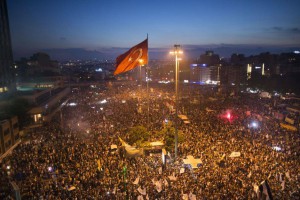GEZI PARK PROTESTS
A wave of demonstrations and civil unrest in Turkey began on 28 May 2013, initially to contest the urban development plan for Istanbul’s Taksim Gezi Park. The protests were sparked by outrage at the violent eviction of a sit-in at the park protesting the plan.Subsequently, supporting protests and strikes took place across Turkey protesting a wide range of concerns, at the core of which were issues of freedom of the press, of expression, assembly, and the government’s encroachment on Turkey’s secularism. With no centralised leadership beyond the small assembly that organized the original environmental protest, the protests have been compared to the Occupy movement and the May 1968 events.Social media played a key part in the protests, not least because much of the Turkish media downplayed the protest, particularly in the early stages. 3.5 million of Turkey’s 80 million people are estimated to have taken an active part in almost 5,000 demonstrations across Turkey connected with the original Gezi Park protest.11 people were killed and more than 8,000 were injured, many critically.
The sit-in at Taksim Gezi Park was restored after police withdrew from Taksim Square on 1 June, and developed into an Occupy-like camp with thousands of protesters in tents, organising a library, medical center, food distribution, and their own media. After the Gezi Park camp was cleared by riot police on 15 June, protesters began to meet in other parks all around Turkey and organised public forms to discuss ways forward for the protests.Turkish Prime Minister Recep Tayyip Erdoğan dismissed the protesters as “a few looters” on 2 June.Police suppressed the protests with tear gas and water cannons. In addition to the 11 deaths and over 8,000 injuries, more than 3,000 arrests were made. Excessive use of force by police and the overall absence of government dialogue with the protesters was criticized by some foreign countries and international organisations.
The range of the protesters was described as being broad, encompassing both right- and left-wing individuals.Their complaints ranged from the original local environmental concerns to such issues as the authoritarianism of Recep Tayyip Erdoğan, curbs on alcohol, a recent row about kissing in public,and the war in Syria.Protesters called themselves çapulcu (looters), reappropriating Erdoğan’s insult for themselves (and coined the derivative “chapulling”, given the meaning of “fighting for your rights”). Many users on Twitter also changed their screenname and used çapulcu instead.According to various analysts, the protests are the most challenging events for Erdoğan’s ten-year term and the most significant nationwide disquiet in decades.
